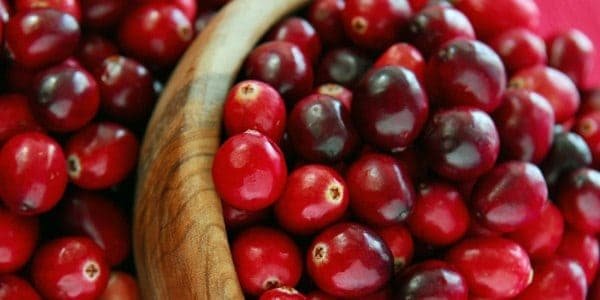Cranberry

The huckleberry is a perennial, low, evergreen shrub, reaching a height of 10 to 20 centimeters, with small and shiny leaves. Its flowers resemble bells up to 5 mm long.
The plant blooms in May, early June. Cranberry fruits are small in size and have a characteristic sweet-sour taste.
The cranberry is a wild forest fruit. It is found in the tundra and also in forested areas in the temperate climate zone.
Mass plantations of cranberry appeared in the 60s of the 20th century in countries such as the USA, Russia , Germany, Finland, the Netherlands, Belarus and Poland.
Thanks to the high degree of mechanization, yields from these plantations are 20-30 times higher than natural cultivation.
Nutritional value of 100 grams of cranberry
• Proteins – 0.7 grams;
• Fats – 0.5 grams;
• Carbohydrates – 8.2 grams;
• Mineral composition – 0.2 grams;
• Water – 86 grams;
• Calorie content – 46 kilocalories;
Since 100 grams of cranberries contain a total of 46 kilocalories, their consumption may not be limited if a person adheres to a diet aimed at reducing body weight.
And people suffering from obesity also need not fear that eating cranberries could further worsen their condition.
Beneficial properties
These fruits contain useful organic acids /citric, salicylic, malic, etc./, pectin, carotene, tannins, vitamins A, C, E. Sugars in cranberries are up to 10 -15% /glucose, fructose, sucrose /, as well as potassium, calcium, magnesium, manganese, iron and phosphorus.
Thanks to the large amount of benzoic acid, these fruits can be stored for a very long time and have preservative properties.
Cranberry leaves contain tannins, arbutin, hydroquinone, tannins and carboxylic acids. The presence of gallic, quinic, tartaric and ascorbic acids was also found.
In the composition of cranberry seeds, fatty carboxylic acids – linoleic and linolenic – have been found.
The evergreen shrub of the cranberry is a valuable healing plant, as medicinal properties are mainly possessed by the leaves.
In folk medicine, these fruits are known as a tonic, wound healing and body temperature lowering agent. And they are also extremely useful for scurvy, avitaminosis, dysentery and even have an anthelmintic effect.
The decoction of the leaves and fruits of this evergreen shrub, when mixed with St. John’s wort, is very suitable for enuresis, better known as urination, and when blackberries are added, it also cures typhus. The liquid extract is sedative and diuretic.
The decoction of cranberry leaves alone is used for diabetes mellitus, rheumatism, kidney diseases, gout and helps to dissolve and remove kidney stones.
Cranberry tea restores strength and relieves fatigue. Bilberry fruits are used for tuberculosis, catarrh of the stomach, kidney stone disease and as a vitamin and anthelmintic.
Cranberry juice sharpens vision and is very useful for neurosis and anemia.
Blueberries have an anti-ulcer effect, reduce blood cholesterol levels, improve the function of the digestive system and lower blood pressure.
Contraindications
The cranberry has an extremely harmful property of absorbing the largest amount of radioactive substances compared to other plants. And this represents a very big danger for the body.
Therefore, it is necessary to select and consume those fruits that are collected as far as possible from busy highways, landfills and factories.



